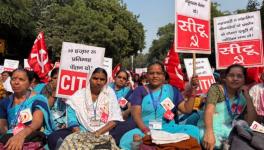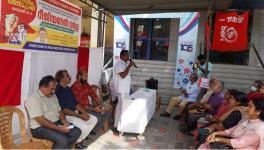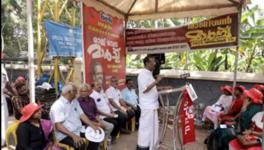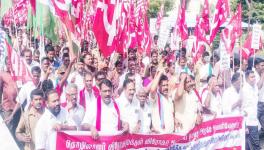5 Sept Workers-Peasants Rally: Agri Workers Demand Land Reforms & Better Wages

On 5 September 2018, a historic rally of industrial workers, farmers and agricultural labourers will storm the country’s Capital demanding better wages, more jobs, better prices for farm produce, end to privatisation and changes in labour laws, ending the contract labour system, etc. The ‘Mazdoor Kisan Sangharsh Rally’ will mark a new stage in the struggle of working people of India for a better life and just future. In the runup to this massive protest, Newsclick is publishing a series focussing on the demands being raised. In Part 2 of this series, read about agricultural workers.
Among those travelling to Delhi to participate in the 5 September rally will be thousands of agricultural labourers from across the country. Making up the poorest, most oppressed section of India’s economy, they make up the largest share of all working people in the country. According to the last Census in 2011 there were 14.43 crore agri. workers in India, which is about one third of the population and 55% of the rural workforce. Their number has been rising steadily every year – between 2001 and 2011, there was an increase of 34% or 3.69 crore.
Agricultural workers include mostly landless labourers and also very small or marginal farmers who cannot sustain themselves from their tiny land holding and are forced to work on other people’s land. Agri. workers work for wages but often, some part is paid in the form of grain or other produce. Due to seasonal nature of work, most agri. workers also work in other occupations including casual work in construction, etc. They also depend on MGNREGS for some supplementary income. About half of the agri. workers are dalits and adivasis.
The life of agri. workers is marked by extreme poverty, intense drudgery, social oppression and deprivation. Their earnings from hard labour are very meagre. Recent studies have shown that after some rise between 2007-08 to 2014-15, rural wages have been stagnating under Modi rule. This is causing immense misery and hardship – but the govt. has no word of solace, leave aside any relief, to offer. Between 2014-15 and 2016-17, real wages (inflation adjusted) of agri. workers have increased by just 1.7% for ploughing, 3.1% for sowing, transplanting and weeding, 0.5% for harvesting, winnowing and threshing, and 2% for unskilled labour. Women agricultural workers usually get much less wages than men. Children from agri. worker families too labour in the fields along with their family members.
The number of agri. workers is continuously increasing because small and marginal farmers, and even many medium farmers, are bearing the brunt of agricultural crisis where farm incomes are shrinking and unremunerative and debt is growing. This twin pressure is leading to lakhs of farmers leaving cultivation altogether and most of them join the ranks of agri. workers. Since there are very limited non-farm jobs, especially in rural areas, the agri. workers are forced to work at poor wages, with seasonal daily wage contractors in civil works or other occupations.
Many agri. workers also undertake migration to other parts of the country in search of jobs. This may be seasonal migration at the time harvesting of crops in high production states like Punjab and Haryana. Migration can also be long term, like going to towns and cities to work in informal sector jobs or in industrial units with very poor earnings.
No Protective Laws
Agri. workers have practically no laws to protect them. All the major labour laws like those for minimum wages, social security (PF and ESI), maternity benefit, regulation of industrial relations etc. do not apply to agri. workers since they are employed under informal conditions by individual farmers on temporary basis. Due to this grave shortcoming in the country’s labour laws, the biggest section of India’s labourers is untouched by any kind of legal protection.
Although many ruling political parties have been talking about bringing a comprehensive legislation for protection of agri. workers, this matter has been hanging fire for over forty years. Some piecemeal attempts have been made, for instance the social security law of 2008, but they remained seriously deficient with just a bureaucracy created in the name of regulation. Declarations of minimum wages, like the one made by the present govt., too remain on paper as there is no implementing mechanism.
Land
One of the most important needs of the agri. workers is for land. However, neither has any govt. taken measures to implement land ceiling laws properly (apart from Left govts.) nor has the seized land been fully distributed among landless labourers.
According to estimates, 5.19 crore acres of land is technically surplus going by the limited land ceiling laws that exist today. However, till 2015, just 67 lakh acres was officially declared surplus by the govts., and out of that, 61 lakh was actually taken over. Out of this taken over land, about 51 lakh acres has been distributed among 57.8 lakh landless families. So, the so-called land reform has addressed a mere 13% of the surplus land. The land distributed among landless families is on average 1.13 acre per family. This is surely not going to help the poor families to make ends meet.
The way various central and state govts. have dealt with the land problem clearly shows that the govt. is keener in protecting the interests of big land owners. They want to preserve the monopoly of 5% land owners who own 32% of this country’s arable land. It has little concern for the suffering of crores of agri. workers who are shackled to poverty because of lack of land. The same attitude is visible with regards to wages, social security and other economic benefits for the agri. workers.
Agri. workers also suffer from very bad housing conditions because of their poor status and meagre income. Most of them live in kuchcha houses with no provision for safe drinking water, electricity or access roads. The govt.’s programmes for housing or other amenities are moving at snail’s pace and thus depriving them of this basic right. Similarly, many agri. workers face extreme difficulties in getting food grain through PDS because of complicated rules and exclusion by the new Aadhaar-linked entitlement framework. Govt.’s pension schemes are worth nothing because they give only Rs.200-300 monthly pension and that too for just about 10% of the eligible people like elderly, differently-abled, widows etc.
The All India Agricultural Workers Union (AIAWU) has been waging struggles for speedy and effective implementation of land reforms and redistribution of land to landless families, increase in wages, comprehensive legislation for protection of agri. workers and their coverage under various programmes for food security, housing, education, health etc. The wave of struggles in recent years by agricultural workers for land, better wages and better amenities in various states has led to their planned participation in the 5 September rally.
[Based on campaign material prepared by CITU]
Part 1: Ensure Jobs for All
Get the latest reports & analysis with people's perspective on Protests, movements & deep analytical videos, discussions of the current affairs in your Telegram app. Subscribe to NewsClick's Telegram channel & get Real-Time updates on stories, as they get published on our website.
























